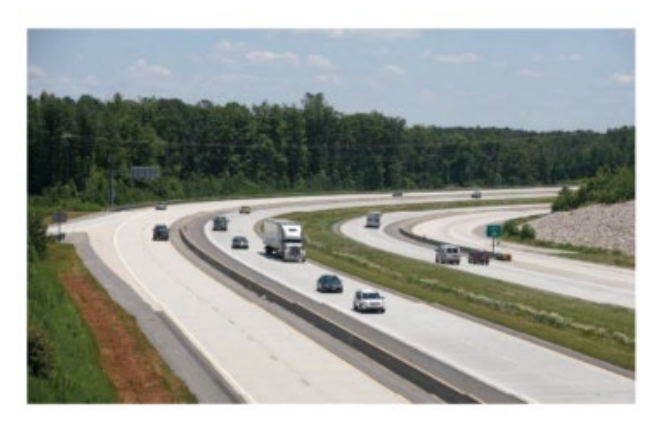8.4 Urban Design Elements
8.4.1 General Design Considerations
Freeways in urban contexts are typically classified as depressed, elevated, ground-level, or a combination thereof. These freeway types are used as appropriate for the surrounding areas or conditions.
Freeways in urban contexts can carry high traffic volumes and may have any number of through-traffic lanes in one direction if the minimum level of service requirements are met. However, it is commonly accepted that freeways become less efficient at widths greater than four lanes in each direction. When more than four lanes in each direction are needed, consideration should be given to implementing a special freeway design. For special freeway designs, see
.
Medians on freeways in urban contexts should be a minimum of 12-ft for a four-lane freeway and 24-ft for a freeway with six or more lanes, and preferably 26-ft with heavy truck traffic to provide a wider shoulder.
Freeways in the urban context typically do not require median crossovers.
8.4.2 Depressed Freeways
Depressed freeways are usually located at a depth of 16-ft or more below the surface of adjacent streets. Major streets pass over this type of freeway, and the depression reduces noise while also allowing surface streets to cross at grade.
Front slopes are not generally used beyond the shoulder of depressed freeways, and in such cases, back slopes should not exceed a slope of 1V:3H. Retaining walls along the freeway should preferably be located a minimum of 2-ft beyond the outer shoulder edge. Minimum median widths should be 10 to 22-ft, and any increase should be in multiples of 12-ft to allow for the addition of more through lanes in the future. Where ROW is extremely limited or costly, walled sections with overhanging frontage roads may be utilized.
8.4.3 Elevated Freeways
Elevated freeways may be used where surface or subsurface ground conditions make a depressed or ground-level freeway infeasible. These can be constructed on either viaducts or embankments depending on current conditions and design requirements.
Elevated freeways allow ground-level traffic to pass underneath, and additional space created beneath the structure can be used for other purposes. These freeways are typically high in cost and are located in dense areas where space is limited. Frontage roads are not typically required due to the elevation difference allowing cross-traffic to operate normally, and an offset of 15 to 20-ft is typically recommended from the structure to surrounding buildings.
8.4.4 Ground Level Freeways
Ground-level freeways are constructed in areas of flat terrain, often adjacent to railroads or bodies of water. These freeways should preferably have one-way frontage roads to provide access to surrounding properties.
Ground-level freeway design should minimize the changes in grade to maintain adequate sight distance. While following the existing profile of natural ground, these freeways can be slightly elevated or depressed to create a smoother drive for motorists.
8.4.5 Combination-Type Freeways
Combination-type freeways use variations of elevated, depressed, and ground-level designs. These freeways may be used where variations in profile and cross sections allow for portions of ground-level freeway combined with sections of either raised or lowered facilities.
8.4.6 Special Freeway Designs
Special freeway designs should be considered when more than four lanes in each direction are needed. Special freeway designs that may be appropriate in some urban area locations:
- Freeways with reverse-flow roadways;
- Dual-divided freeways; and
- Freeways with C-D roadways.
Refer to
for more information on special freeway designs.
8.4.6.1 Freeways with Reverse-flow Roadways
A reverse-flow freeway offers two distinct directions of traffic flow as well as a center section which operates in the peak flow direction during peak demand periods. This is usually accomplished by situating a separate reversible roadway within the normal median area. See
for an example of a reverse-flow roadway.
8.4.6.2 Dual-divided Freeways
A dual-divided freeway may be designed when more than eight total lanes are needed and the traffic in either direction is distributed equally. This may be a practical solution when widening an existing freeway where existing traffic volumes should not be disrupted.
One benefit is the ability to close one of the directional roadways for maintenance or construction. One disadvantage, however, is the needed width for shoulder area which may impact surrounding property and terrain.
provides an example of dual-divided freeway.
8.4.6.3 Freeways with C-D Roads
For Freeways with a C-D road, see
.

Figure 8-12: Example of Reverse-flow Roadway
Source: AASHTO A Policy on Geometric Design of Highways and Streets

Figure 8-13: Dual-divided Freeway
Source: Virginia DOT